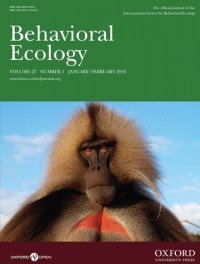Behavioral Ecology Q1 Unclaimed
Bringing together significant work on all aspects of the subject, Behavioral Ecology is broad-based and covers both empirical and theoretical approaches. Studies on the whole range of behaving organisms, including plants, invertebrates, vertebrates, and humans, are included. Behavioral Ecology construes the field in its broadest sense to include 1) the use of ecological and evolutionary processes to explain the occurrence and adaptive significance of behavior patterns; 2) the use of behavioral processes to predict ecological patterns, and 3) empirical, comparative analyses relating behavior to the environment in which it occurs. It has an SJR impact factor of 0,925.
Behavioral Ecology focuses its scope in these topics and keywords: behavioral, ecology, coloration, approachbehavioral, attractive, beekman, bounds, building, buteo, buteoelevationrelated, ...
Type: Journal
Type of Copyright:
Languages: English
Open Access Policy: Open Choice
Type of publications:
Publication frecuency: -
2700 €
Inmediate OANPD
Embargoed OA0 €
Non OAMetrics
0,925
SJR Impact factor136
H Index124
Total Docs (Last Year)438
Total Docs (3 years)8980
Total Refs928
Total Cites (3 years)396
Citable Docs (3 years)2
Cites/Doc (2 years)72.42
Ref/DocOther journals with similar parameters
Fungal Diversity Q1
Genome Biology Q1
Annual Review of Ecology, Evolution, and Systematics Q1
Trends in Ecology and Evolution Q1
Annual Review of Entomology Q1
Compare this journals
Aims and Scope
Best articles by citations
No phenotypic signature of acoustic competition in songs of a tropical cricket assemblage
View moreThe evolution of progressive provisioning
View moreResponses of breeding Cory's shearwater Calonectris diomedea to experimental manipulation of chick condition
View moreDirect fitness benefits and kinship of social foraging groups in an Old World tropical babbler
View moreInfluence of immediate predation risk by lions on the vigilance of prey of different body size
View moreStriving for transparent and credible research: practical guidelines for behavioral ecologists
View moreFemale choice for male immunocompetence: when is it worth it?
View moreFemale choice for related males in wild red-backed toadlets (Pseudophryne coriacea)
View moreNest and mate choice in the red bishop (Euplectes orix) : female settlement rules
View moreHelping effort in a dominance hierarchy
View morePrior exposure to male phenotypes influences mate choice in the guppy, Poecilia reticulata
View moreCuticular hydrocarbons as potential kin recognition cues in a subsocial spider
View moreAssortative interactions revealed in a fission-fusion society of Australian humpback dolphins
View morePaternity and paternal effort in the pumpkinseed sunfish
View morePaternity in mallards: effects of sperm quality and female sperm selection for inbreeding avoidance
View moreResource redistribution in polydomous ant nest networks: local or global?
View moreExperimentally induced spermatophore production and immune responses reveal a trade-off in crickets
View moreEvading invaders: the effectiveness of a behavioral response acquired through lifetime exposure
View moreNest mate recognition in ants with complex colonies: within- and between-population variation
View moreEffects of predation risk and group dynamics on white-tailed deer foraging behavior in a longleaf pine savanna
View moreIndividual flexibility in nocturnal activity reduces risk of road mortality for an urban carnivore
View moreIdeal gas model adequately describes movement and school formation in a pelagic freshwater fish
View moreEncounter rates with conspecific males influence female mate choice in a naturally hybridizing fish
View moreEvolution of black grouse leks: female preferences benefit males in larger leks
View more


Comments